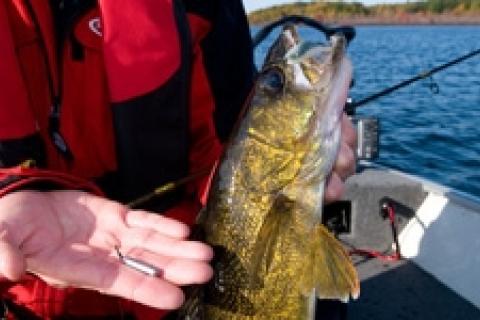
 Although earmarked for bass, a drop-shot is a stellar presentation for walleye. This method routinely puts fish in my net from season opener to days before ice-up. Here are some tips for catching 'eyes with this winning rig.
Although earmarked for bass, a drop-shot is a stellar presentation for walleye. This method routinely puts fish in my net from season opener to days before ice-up. Here are some tips for catching 'eyes with this winning rig.
Micro Swivel Miracles
Nothing ruins a presentation faster than unappealing bait-spin caused by line twist. Drop-shotting is particularly susceptible to this, so I always tie-in a micro swivel 24 to 30 inches above the hook. Whether you use monofilament, fluorocarbon or Superline, this piece of hardware will save you a lot of headaches and catch you more fish.
Get Some Meat On
I thread on at least half an inch of the bait on the hook shank. This extends the bait's lifespan longer than lightly nose-hooking a plastic. It also positions the hook point closer to the bait's tail, which helps hook light-biting walleye.
Top Picks
An array of baits work on a drop-shot. Artificial worms, finesse minnows, leeches, and teaser-tail baits are all good bets. Bear in mind, however, that live bait is always a reliable choice for this rig.
Consider Casting
Known as a vertical presentation, don't be shy to cast this rig and retrieve it along bottom. A drop-shot's architecture ensures the bait is always up off the floor, portraying vulnerability as it swims through "no man's land" off bottom — a sight few walleye can resist attacking.
A Successful Sword
Although not mandatory, using a drop-shot rod will deliver the perfect blend of characteristics needed to present this set-up. One critical feature is that the rod has a soft tip to deliver a seductive shake to the bait, but also to signal light bites.
Top Spots
Here are some of my favorite areas to work this versatile rig.
- Structure that's conducive to jig fishing is drop-shot territory, such as points, drop offs, humps and saddles.
- Deep weed edges are also prime areas. Use short casts and then work the rig back using a shake-pause retrieve.
- Casting deep sand and mud flats is another reliable approach. The dragging sinker will kick-up a silt-cloud trail that calls in walleye. Generally, I reserve this method once I've dialed in fish location with a more time-effective search lure, like a crankbait or swimbait.
- Don't overlook this rig when fishing a river. Productive areas include eddies, deep holes, rocky drop offs and ledges, slack water behind current breaks, and shallow bars. Maintain bottom contact and let the bait dance in the flow.
- 4693 views

